I went out at 11:30 am, starting my adventure at the intersection of Bloor Street West and Avenue Road. I had thought I would walk south through Queen’s Park Crescent and the tractors I’d seen the night before, then on to the Medical Arts Building where health care workers were planning a counter protest. However, the stretch of road between Bloor and the Cenotaph at the north end of Queen’s Park had been cleared. No more tractors.
Two relatively small groups had gathered at the intersection, one on the north side of Bloor and on the steps of Church of the Redeemer, the other on the south side of Bloor. Police held to a line across the south side of Bloor to prevent vehicles from going south to Queen’s Park. Another group of police stood by the group on the north side trying to calm some angry yellers. The group on the south side supported the Freedom Convoy and behaved in a calm and dispassionate manner while the group on the north side opposed the Freedom Convoy and was rabidly angry. “Go home! You’re not welcome here! You’re all a bunch of morons!” It was a strange reversal where the ones critical of irrationality were being irrational and threatening to turn this into a violent confrontation. It was a clear demonstration of how bad behaviour immediately destroys credibility and only affirms and entrenches those who hold an opposing view.
Into the middle of this, a Black man appears and shouts: “No one is welcome here! We’re on Native land. You want to fight?” He points to a snow bank. “Plenty of snow here. Let’s have a snowball fight.” His was the most sensible voice I heard all day.
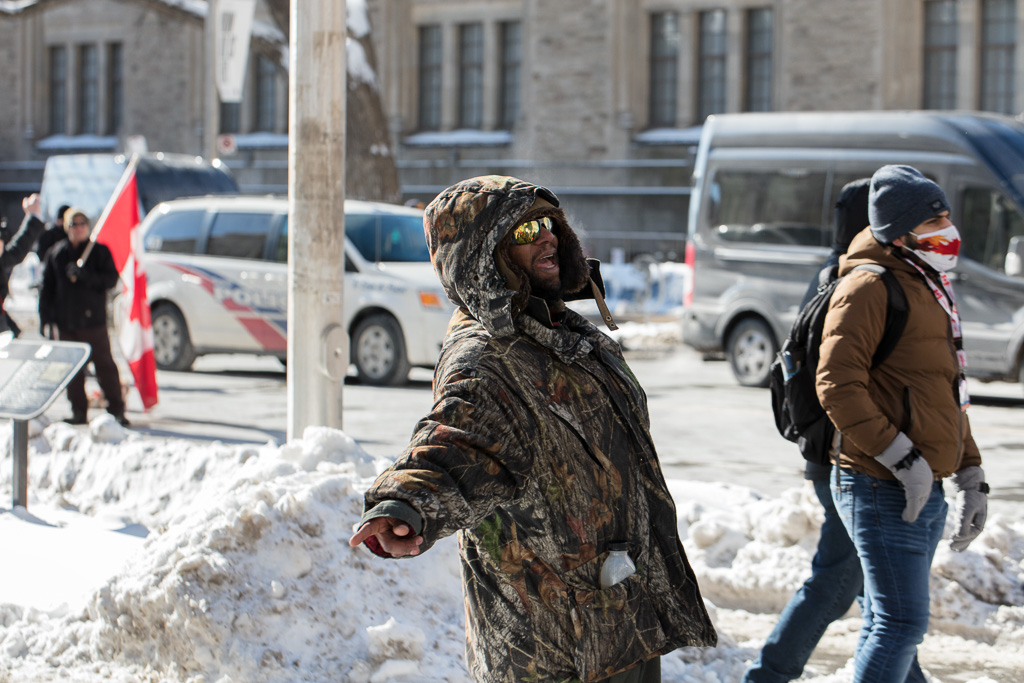
I stayed to photograph a few people, still thinking I might make it to the Medical Arts Building. There was a guy with a GoPro style camera on a stick, whipping it around in every direction, live streaming to his people, Freedom Convey surveillance. He moved so fast, I suspect his viewers were getting motion sickness. We spoke for a minute and that was the first of what I presume are hundreds of video and photo appearances I made in other people’s private records of the day. Everywhere I walked, people had iPhones held high overhead, a lot of times talking to the screen, either recording themselves in situ or on FaceTime with friends.
The guy with the GoPro called the yellers Antifa which remains, for me, a strange epithet given that the phrase began its life as a contraction of anti-fascist but has since morphed into a pejorative. After witnessing the rabid bile verging on violence that spewed from the anti-Convoy yeller’s mouth, I’m beginning to think there’s merit in a separate and pejorative epithet. I am anti-fascist. Maybe we can reserve Antifa for anti-fascists who get so worked up their behaviour is indistinguishable from their fascist counterparts.
The guy with the GoPro asked if I supported the movement. Ah, the moment of reckoning. I stared into his video camera and said “No.” Then I qualified my answer by saying: “But I’m not here to stir up a fuss like these people.” We chatted a bit, moderates standing on opposite sides of our neighbourly fence. I asked where all the people were; I was expecting a bigger crowd. He said they were all gathering in the park, and he waved to the south and told me they were giving out free food if I liked. And that is why I never made it down to the Medical Arts Building.
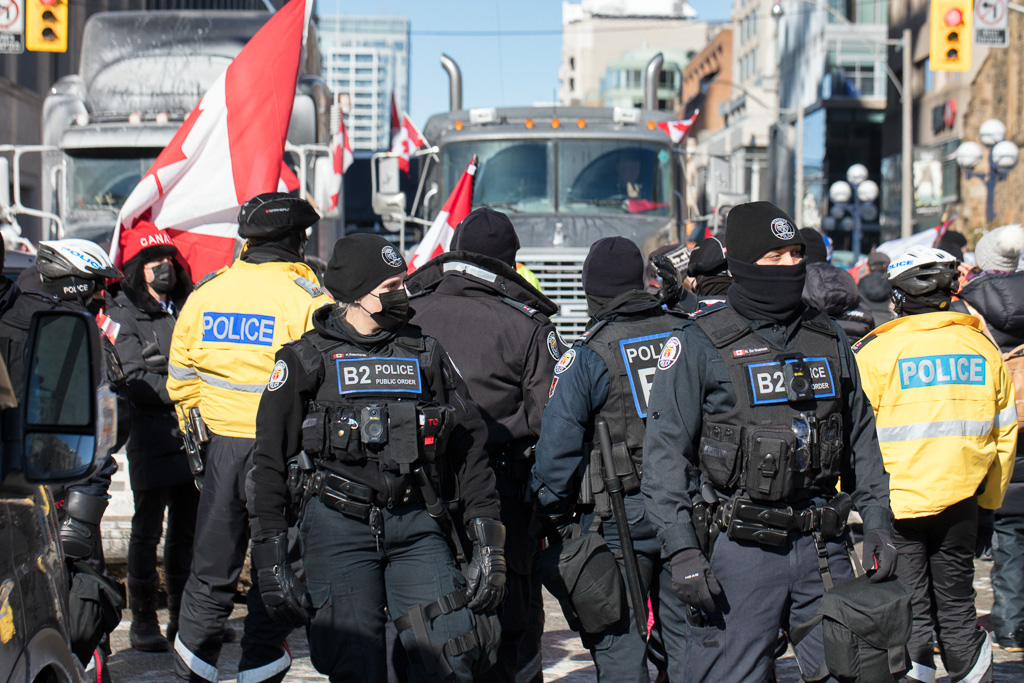
I joined a thin line of people walking south to a crowd gathering around the monument of King Edward VII riding his horse. When I was an undergraduate, engineering students routinely painted the horse’s penis bright red. If it wasn’t a gelding then, it is now, saving cleaning time whenever people restore the genitals. With all the cleaning, the horse’s penis is the shiniest part of the monument.
Once I arrived at the gathering, I realized that this didn’t have anything to do with the Freedom Convoy but was the usual weekly protest that’s has been inflicting itself on the city of Toronto since our first lockdown in March of 2020. Previously, I’ve caught them on the move—they rally, then march through the streets—but I’ve never bothered to go to a rallying point before. My sense is that the expected arrival of truckers has given the group a jolt of energy.
I have a few observations about the group:
1) It was overwhelmingly white. Whatever claims it makes for itself about representation and speaking for all Canadians, the composition of its membership says otherwise. When I arrived, a DJ was playing reggae, as if to say: when you enter this space, you must check your cognitive dissonance at the door.
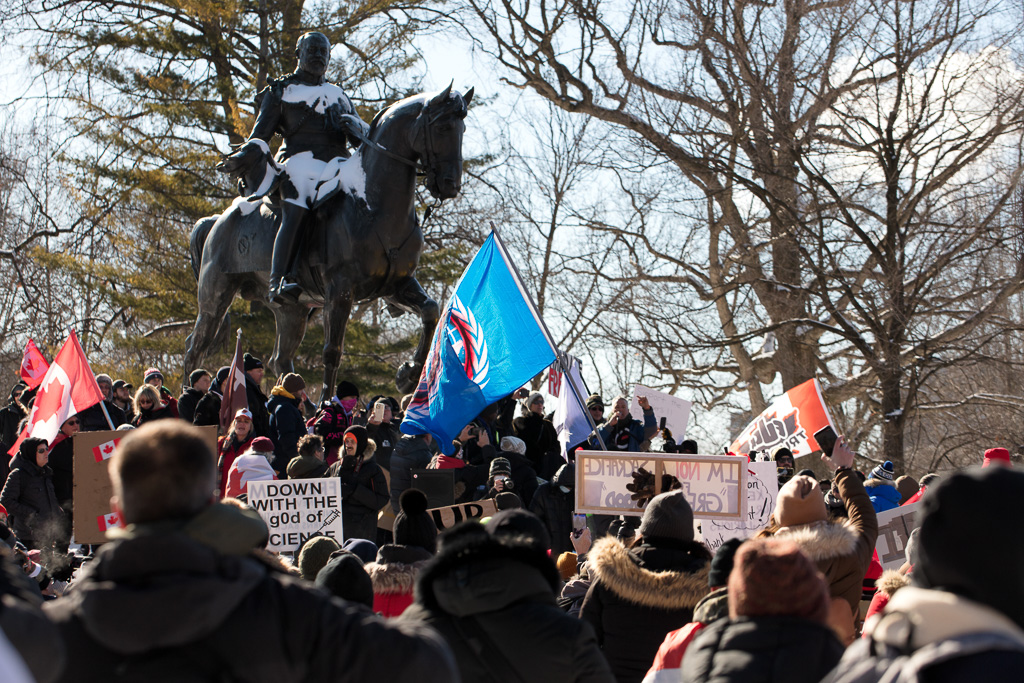
2) Exaggerated numbers. In a moment reminiscent of Trump’s inauguration, the emcee, whose name I should know but don’t care to share, announced that there were 15,000 people gathered there. Eyeballing the crowd, I’d hazard to guess he was off by an order of 10. If there were more that 1,500 people gathered around Edward VII and his well hung horse, it was only because photographers like me had insinuated ourselves into the crowd.
3) I was struck by the number of Canadian flags, many strung from hockey sticks. They couch their speech in patriotism. They are taking a stand for the country. Many of these people literally drape themselves in the flag. I couldn’t help but think of the famous Samuel Johnson observation which, I suspect, isn’t so famous in these parts. To clarify, Johnson didn’t say there was a problem with patriotism; he said there was a problem with patriotism when self-interested people invoke patriotism for their own ends. And so: “Patriotism is the last refuge of a scoundrel.” I thought, too, of Aldous Huxley, who wrote about how tempting it can be to lose ourselves in the expansive feeling that we are part of something larger. He identified this feeling as a form of “downward self-transcendence.”
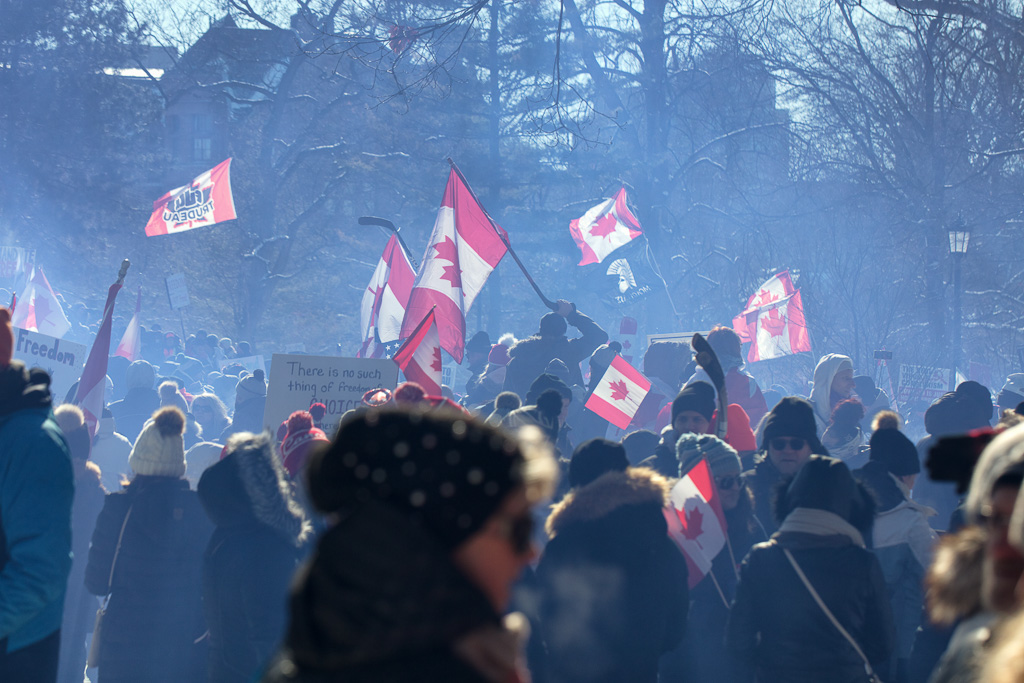
4) Despite claims of inclusion, things unfolded beneath the aura of a conservative Christian church liturgy. The emcee invited a pastor to deliver a prayer. Technically, there was never a prayer, more a brief homily on liberty in answer to people who chanted “liberty” over and over with fists raised overhead. For a brief moment, I felt like an extra in the third installment of Indiana Jones when Indy finds himself in the middle of a Nazi rally. While I make light of it now, at the time, I felt a chill down my spine. “So this is what it feels like,” I said to myself. I took consolation in the fact that nobody in this space is a person of any authority. However, it does suggest that if somebody with far-right leanings should come to power in the near future (I’m thinking of the CPC leadership struggles), they would have a ready-made cadre of foot soldiers to fight in their miserable little war.
The group rounded out its religious observances with the national anthem which neatly ties patriotism and religion in one unholy knot. Amen. I felt weirdly ambivalent as people all around me belted out “God keep our land, glorious and free.” I love this place where I was born. I love the city of my birth. I love travelling to the north where the landscapes fill me with awe. I love the tang that fills my nostrils when I stand on the eastern shores. I love the west coast vibe. I love the distinctive life in the Province of Quebec, especially Montreal where I spent so much time as a child. I love the overwhelming sense of scale you feel as you leave Ontario’s forests at the Manitoba border and head out across the prairies. I love it all, but not to the exclusion of the wider world, and certainly not at all costs. There are more important things than love of country. Justice comes to mind.
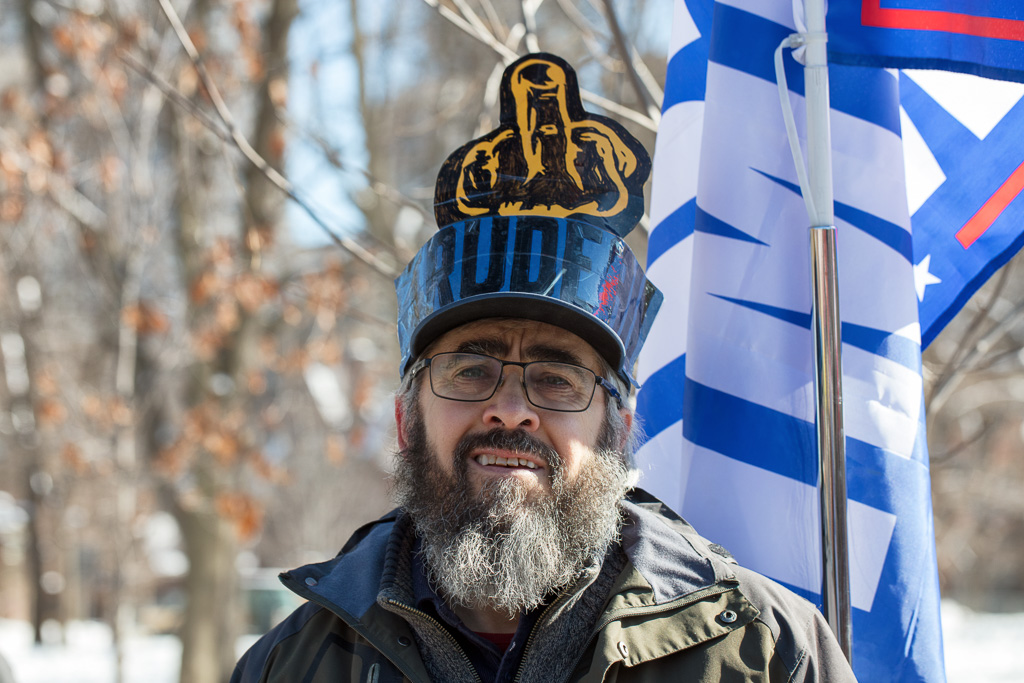
5) The strange deployment of irony. Part of the reason I never succumb to all the excitement of groups like these is that I view the world through the eyes of acute irony. I have it on good authority this is a classic view engendered by the urban perspective, and is particularly endemic to Toronto. While an ironic stance has its downside (I don’t often get caught up in the moment), it has its benefits too. For example, it inoculates me against Johnson’s disingenuous patriotism and Huxley’s downward self-transcendence. It is jarring, then, to encounter true believers (i.e. people for whom irony is not the default perspective) attempting to deploy irony. At least that’s what I think they’re doing; it’s hard to tell.
So, for example, we have the case of a woman who was wearing a tin foil hat. In a simpler time, I would have taken her for someone who was engaged in a stunt to make fun of the anti-vax true believers. But no, she was an insider, making fun of all the people who make fun of anti-vax true believers by calling them conspiracist tin foil hat wearers. I suppose this is what passes for irony in these parts. Meanwhile, immediately next to her was a woman holding up a sign that read: “Engineered virus spread via Engineered Weather” with a URL in case you doubt the sign’s claim. Ironic? Unironic? You be the judge.

Summoned by the horns to the north, I left just before they pronounced a benediction over this little liturgy. Things had changed at the Bloor/Avenue Road intersection. Dump trucks had rolled down Avenue Road and parked themselves in the middle of Bloor, bullying their way inch by inch into the police cordon. Meanwhile, lines of vehicles (mostly Dodge Rams and Ford Pickups) had backed up Bloor in both directions. People leaning on their horns. People shouting and screaming. It grew more chaotic when the 15,000 anti-vaxxers from Queen’s Park swelled the crowd to at least 3,000 people.
I’ve been to Pride Parades beyond counting, and I’ve been to sports championship celebrations like the Argos and the Raptors (not the Leafs, of course) and, by comparison, this gathering was a piffle. I think it’s important to bear that in mind when considering what weight to give it in the scale of our public conversations. The media have done us a disservice by giving them an outsized presence. What we have here are people who started with an obvious and understandable frustration (we can all agree that pandemic restrictions are psychologically and economically wearing) and have grafted to it more pernicious concerns: whiteness, immigration, political entitlements, the authority of science, the role of public institutions, the role of women. I say yes to the frustration. No to the rest of it.
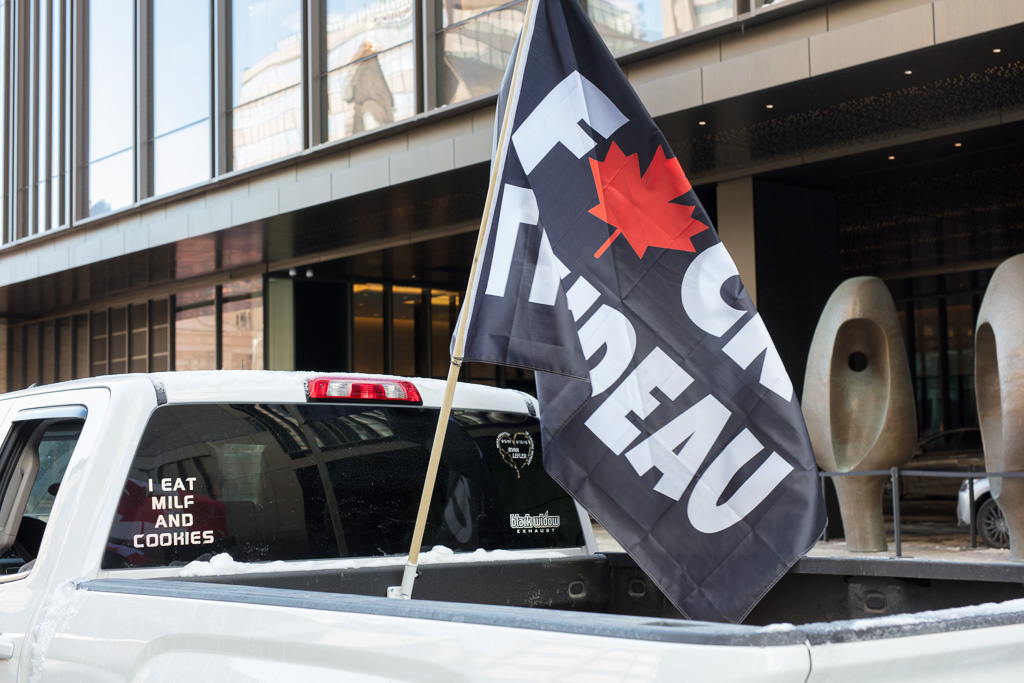
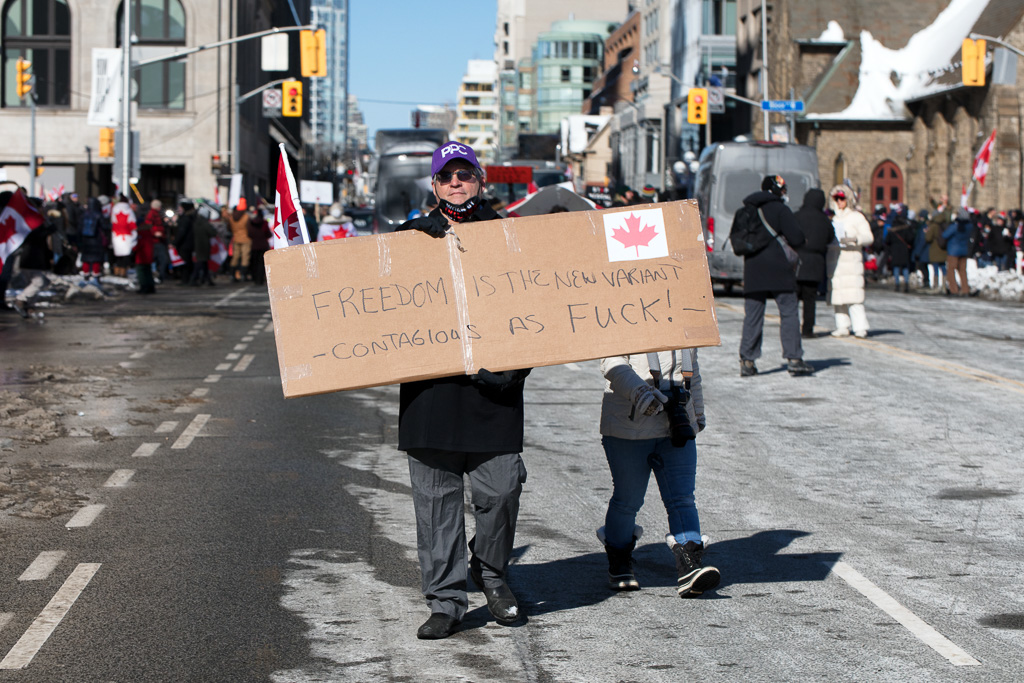
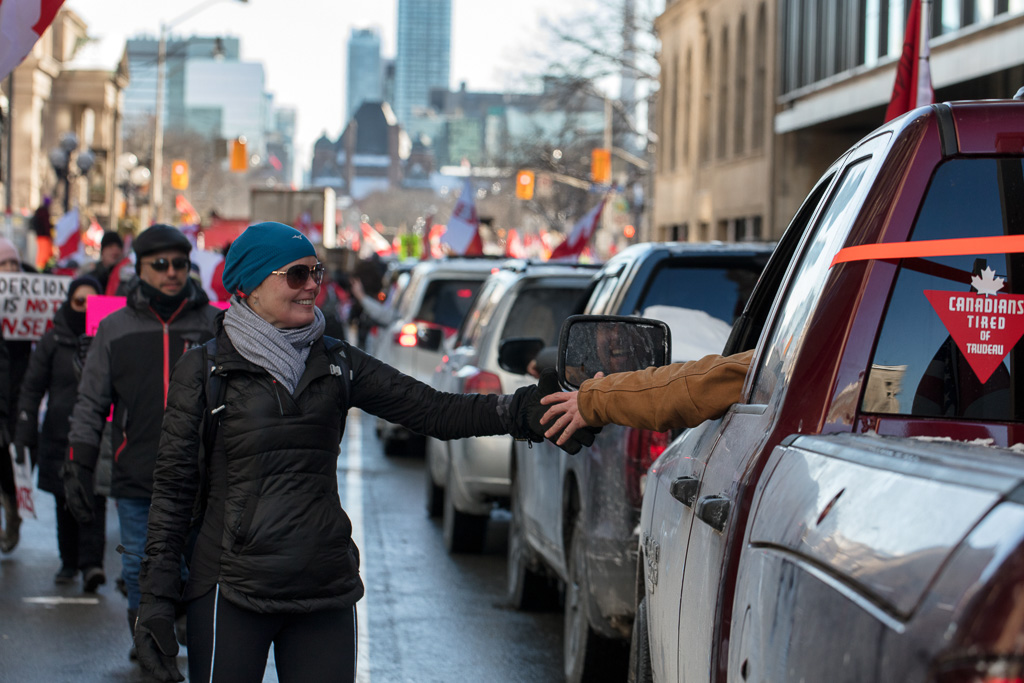
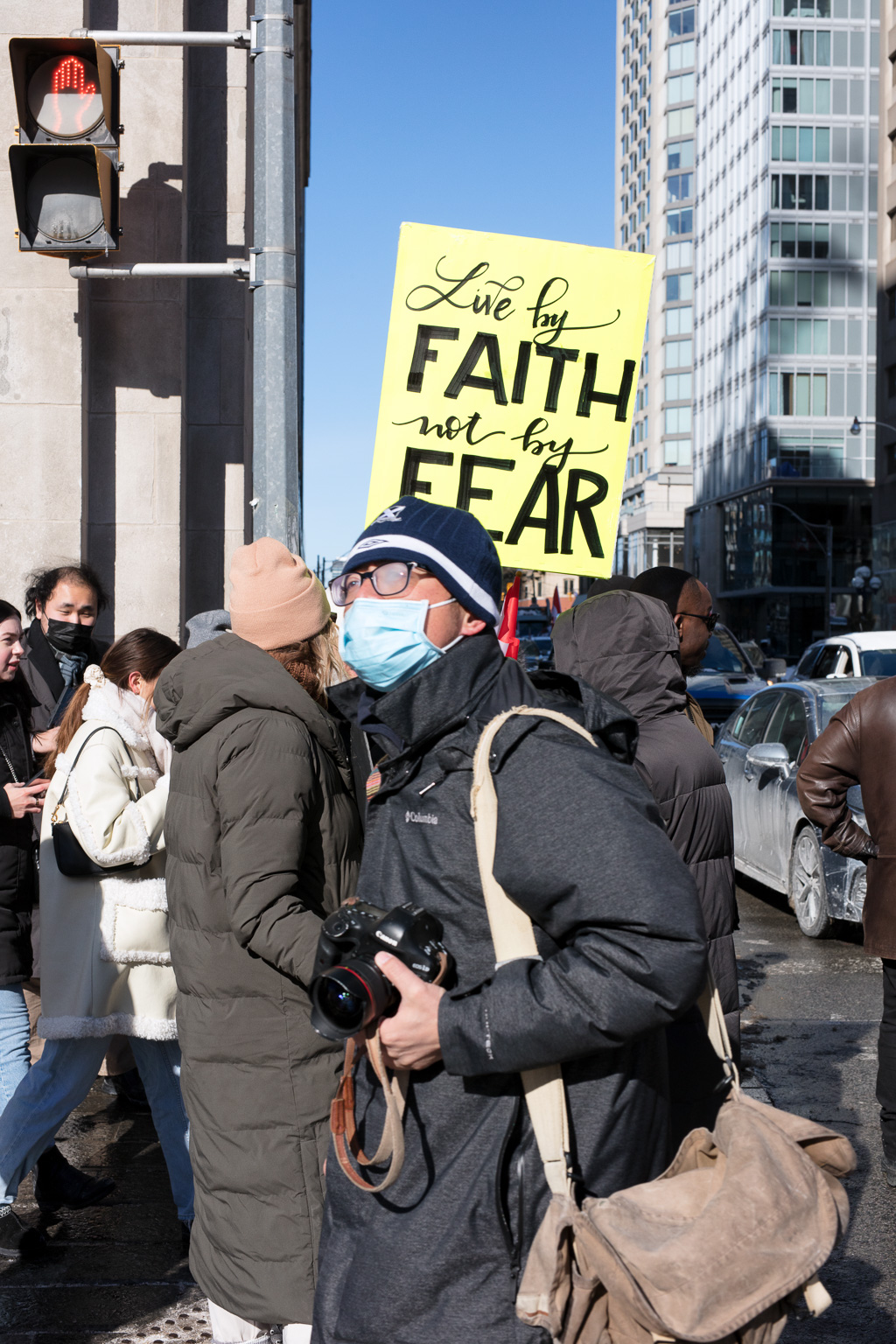
David, this is not merely brilliant, it is deeply temporal. The authentic irony, whether Toronto-copyright or no, is a refreshing change from endless comparisons with the US, Nazi-ism and forecasts of doom. It’s about now, not an unchangeable past or unknowable future.